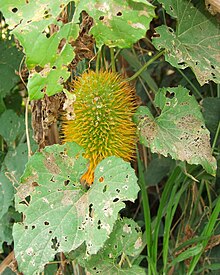Momordica foetida
| Momordica foetida | |
|---|---|
 |
|
| Scientific classification | |
| Kingdom: | Plantae |
| (unranked): | Angiosperms |
| (unranked): | Eudicots |
| (unranked): | Rosids |
| Order: | Cucurbitales |
| Family: | Cucurbitaceae |
| Genus: | Momordica |
| Species: | M. foetida |
| Binomial name | |
|
Momordica foetida Schumach. |
|
Momordica foetida is a perennial climbing vine native of tropical Africa, closely related to the bitter melon (M. charantia) and balsam apple (M. balsamina). Its species name ("bad-smelling") refers to its unpleasant smell. It was previously named M. morkorra (A. Rich) and M. cordata (Cogn.)
The plant grows in forest edges and similar habitats (including disturbed and cultivated land), woodland, and wooded grassland. Its leaves are wrinkled, heart-shaped with irregular edges, up to 18 cm wide. The flowers are yellow to yellow-orange. The fruit is a prolate spheroid, 3.5–7.5 cm long and 2.5–5 cm wide, bright orange and covered with soft spines. When fully ripe it splits from the bottom into three valves, exposing a cluster of black seeds, individually covered by a bright red, sticky, sweet pulp. The plant has perennial tuberous roots.
Local names for the plant include concombre sauvage (French for "wild cucumber"), nyanya-nua, sσprσpσ, kakle, awoduan ("snake food"), aoasongo, gaayama, nanïa, n-gessannia, boobo, bobonowron, vovolé, vovoné vono, hepa, ìsúgū, alu-osi, akb’an’udene, ejìnrìn, tsekiri, and a-bos-a-wir.
The leaves have a bitter taste but it is eaten in Gabon and Malawi. The fruit is edible and is consumed in various countries, including Ghana, Gabon, Sudan and Tanganyika. The root is considered edible in Sudan.
Like its relative M. charantia, the plant contains a number of bioactive compounds, including sitosteryl glucoside, 5,25-stigmastadien-3β-yl glucoside, and 1β-hydroxyfriedel-6-en-3-one, and several cucurbitane-type triterpenoid derivatives.
...
Wikipedia
